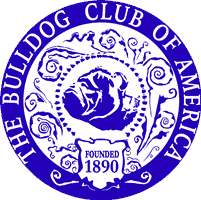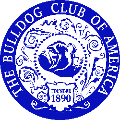AKC Gazette
November 1994
Richard R. Maze
A GOOD BULLDOG CANNOT BE A BAD COLOR!
Guest columnist is Carole Williams.
A Good Bulldog Cannot Be A Bad Color!
What specific and unique color comes to mind when you think of Bulldogs? Chances are a myriad of colors flash through your mind. White, fawn in all its shades, brindle, the color of your current favorite Bulldog or one from the past.
If I asked you to think of a breed that is a solid color (solid white, solid fawn, solid black), would the Bulldog immediately come to mind? Probably not, Most Bulldog colors are broken up with white markings. Many are piebald and the whites usually have some ticking or other evidence of color.
If I asked how important coat color is to you, would you say color is more important, than attitude, expression, gait and size? According to the Bulldog standard scale of points, it is.
Does it really matter what color a vigorous, healthy, sound dog is? Bulldog people do not care about color except for personal preference. They do not breed for color, as in some other breeds. If Bulldoggers were as concerned about color as the standard implies, they would use breeding charts and graphs like breeders of, for example, the Shetland Sheepdog.
Bulldogs are not a breed identified by color. Why then, does the standard list color preferences? The Bulldog Club of America’s standard was adopted in 1896 and has changed very little since then. It states, “The various colors in the breed are to be preferred in the following order: (1) red brindle, (2) all other brindles, (3) solid white, (4) solid red, fawn or fallow, (5) piebald, (6) inferior qualities of all the foregoing …. Solid black is very undesirable, but not so objectionable if occurring to a moderate degree in piebald patches.
No one knows why the authors of the standard listed these colors in this order. There appears to be no reason except their personal preference. Most breeders and exhibitors could not tell you what the preferred colors are. They are far ore interested in the more important aspects of the breed.
Why does the standard list a color preference and why did its authors consider black objectionable? History provides a clue.
A Bulldog club was first formed in England in 1864. According to Edgar Farman’s “The Bulldog Monograph,” “Its work …. Considered for the most part in doing nothing. So thoroughly did it do this that I came to a full stop from pure inability to exist any longer…. In the midlands at the period of which I am now speaking, there were to be found quite a number of black Bulldogs with pepper coloured limbs; they were known as black backed Bulldogs but the purity of their blood is questionable.”
It was during the period of this club’s existence that the Philo-Kuon standard was written. At this time the breed was at a very low ebb. A Mr. Adcock had imported Spanish Bulldogs to improve his strain. Since it was believed this strain would increase the size of the breed to 100 to 120 pounds, the English Bulldog fanciers united against the possibility and formed the Bulldog Club, which was incorporated in 1875. It is believed Adcock’s Spanish imports were black, so black was listed as undesirable.
The Philo-Kuon standard stated, “COLOUR should be salmon, fallow, red brindled or white with these colours variously pied. The salmon and fallow with black muzzles called ‘smuts’ are choice colours. Some greatly admire the white, but a bright salmon with black muzzle would be the choicest of all colours. Black was formerly considered a good colour but black and tan and blue are very bad colours. There is a strong resemblance between a brindle Bulldog and a striped hyena.”
Obviously the color our standard most favors, brindle, was not held in high esteem then. Black had been acceptable; it went out of favor because of Adcock’s Spanish Bulldogs. Is this a valid reason to shun black today? I think not. No lethal gene or genetic defect is linked to color in Bulldogs. There is no reason for the list of color preferences and there is no reason to object to black. The standard should be changed.
A standard of excellence for a breed is used as a guide and is studied by judges, exhibitors, breeders and others. It must be clear and reflect the truth of a breed. We cannot keep a standard solely because it was written that way a long time ago. It is not a sacred cow. If facts are not stated clearly in the standard we cannot expect judges to do a competent job. If the standard is so ambiguous that extensive seminars and training sessions are needed to explain it, there is something wrong. Perhaps the standard should be discussed with a disclaimer, “Just disregard the part about color preference.”
Who cares what color a sound, balanced, vigorous dog is? If most fanciers still consider solid black a bad color (although there is no reason for it) make it a disqualification. Otherwise, allow it with the other colors. If we want good breeding, exhibiting and judging, our standard must be specific. Even the constitutions of the AKC and the USA can be amended. Is the Bulldog standard more sacred? – CW
Carol, we appreciate your strong opinions and reasoning on how, why and when the Bulldog standard should be changed.
Richard R. Maze, 45 Carolane Trail, Houston, TX 77024-5120.


